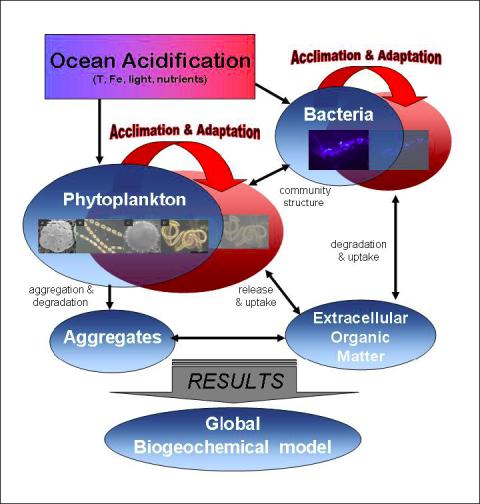BIOACID I – Theme 1: Primary Production, Microbial Processes and Biogeochemical Feedback
Overarching questions
- How do marine primary producers and heterotrophic bacteria of diverse taxonomic groups respond to ocean acidification (OA) and increase in CO2 concentration on? Which groups/species (e.g. calcifying vs. non calcifying species) are negatively impacted and which benefit?
- To what extent will key phytoplankton species and bacteria be able to acclimate to OA? What is the potential for evolutionary adaptation and concomitant genetic changes within 100s to 1000s of generations?
- What are the consequences of ocean acidification for the turn-over and export of organic matter?
- What are the combined effects of CO2 and temperature changes on the marine soft tissue pump and DOC export and the air-sea exchange of CO2?
Primary producers in the marine realm encompass phylogenetically very diverse groups (Falkowski et al. 2004), differing widely in their photosynthetic apparatus and carbon enrichment systems (Giordano et al. 2005). Preliminary data reveal that species with effective carbon concentration mechanisms (CCMs) are less sensitive to increased CO2 levels than those lacking efficient CCMs, analogous to findings in terrestrial vegetation. Currently, our ignorance of the metabolic diversity of oceanic autotrophy and microbial heterotrophs hampers any projection of total marine primary production and regeneration in response to increased carbonation. A focus of Theme 1 will therefore be to identify critical physiological traits that determine the sensitivity of key groups of primary producers and bacteria to increases ocean acidification and carbonation.
Most of the biological oceanic carbon uptake is driven by regenerated production and only ~20% by new nitrogen input to surface waters (Laws et al., 2000) which drives the export of organic carbon from surface waters (Eppley and Peterson 1979). While the export of carbon, nitrogen, and phosphorus is generally considered to be closely coupled in marine biogeochemical cycling, recent work in mesocosms shows increasing C:N and C:P ratios during primary production with increasing CO2 concentrations (Riebesell et al., 2007). Excess carbon assimilation partially ends up as dissolved organic carbon and may increase the export of organic matter through the formation of gel particles that enhance particles aggregation, such as transparent exopolymer particles (Arrigo, 2007; Engel et al., 2004). These processes, if representative for pelagic autotrophic communities, could give rise to a biologically driven feedback to the climate system.
What controls the release of dissolved organic matter by either phytoplankton or bacteria, and how these substances affect the nutrition and aggregation of pelagic organisms needs further investigation in order to improve the description of biogeochemical turnover processes and their sensitivities to increasing pCO2 (Figure 4).
Theme 1 will study plankton communities in controlled lab experiments on several relevant time scales, from short-term physiological adjustment, to acclimation, to longer-lasting evolutionary adaptation. Treatment levels, experimental set-ups and response variables were chosen concordantly among diverse target groups in order to ensure full comparability of results in the subprojects.
Theme 1 will combine laboratory-based work with field campaigns to assess the responses of natural plankton communities. Given the importance of coastal areas to fisheries and other marine resources and services, the coastal ecosystems constitute an important target region. Insitu experiments and sampling will be carried out in the Baltic Sea, an enclosed sea with high nutrient input and anthropogenic pressures.
An improved implementation of possible impacts of ocean acidification and sea surface warming influence on the marine soft-tissue pump and the cycling (and export) of dissolved organic carbon in global marine carbon cycle models, like the model PICES, is urgently needed. As part of the modeling component of Theme 1 new parameterizations will be incorporated based on empirical results generated under this theme.
